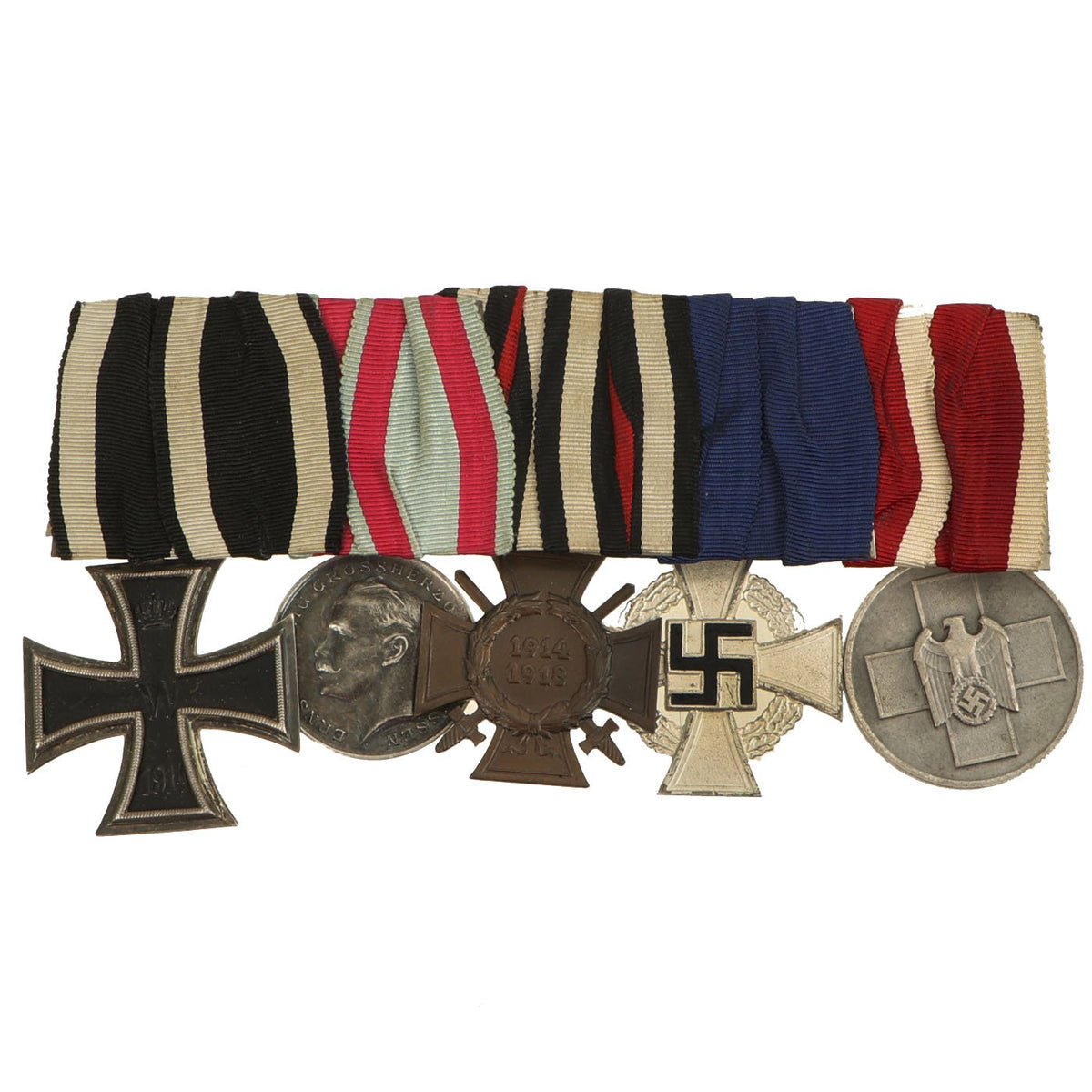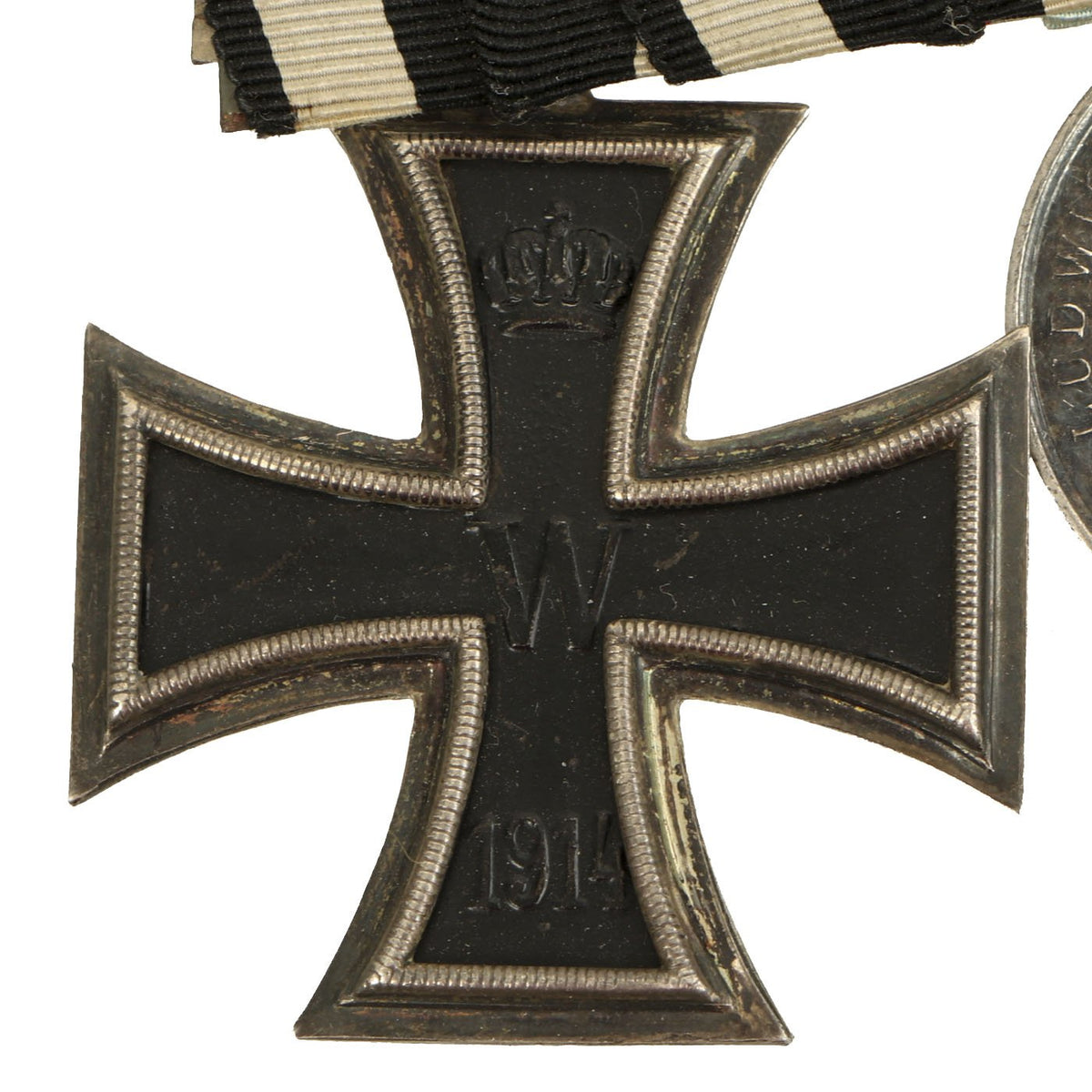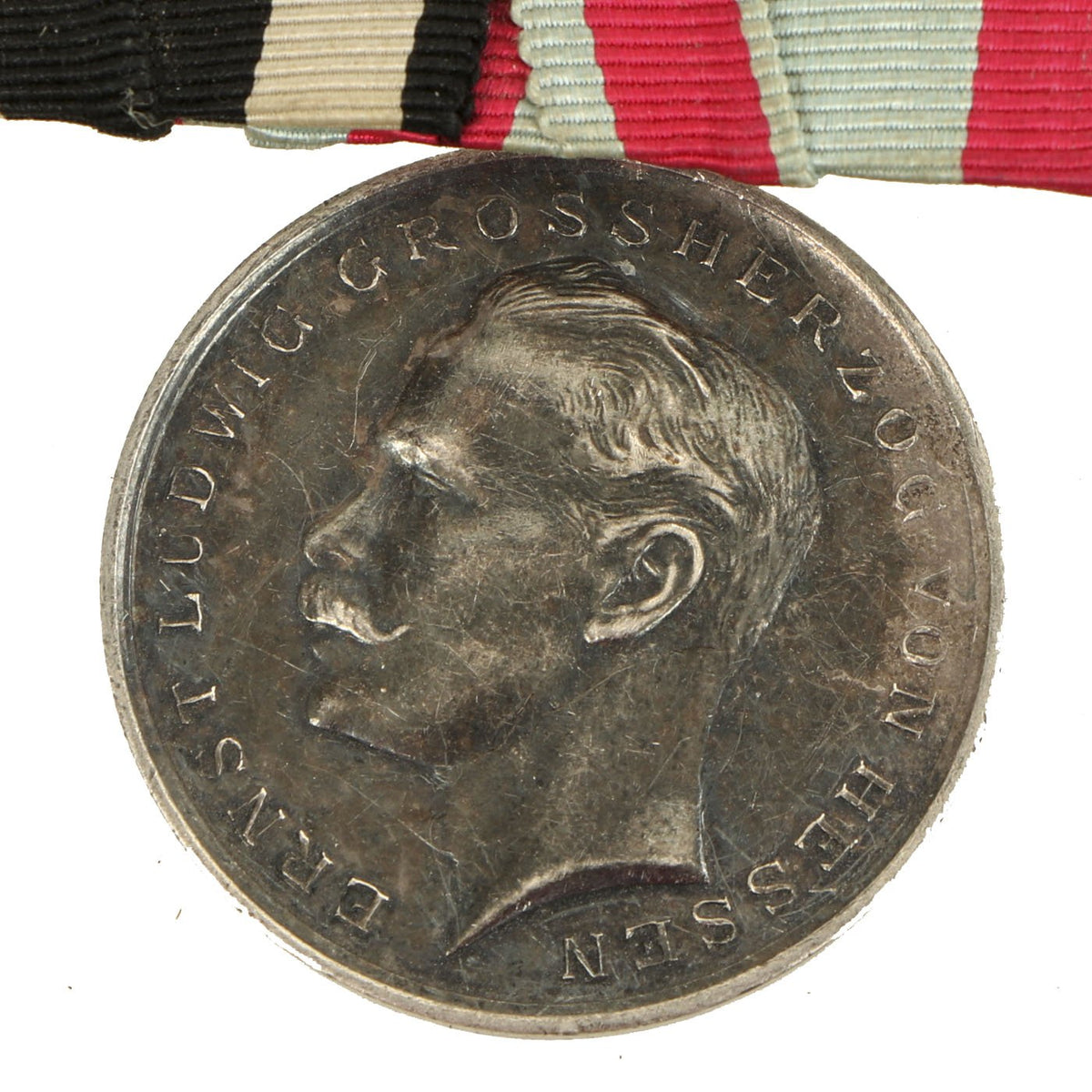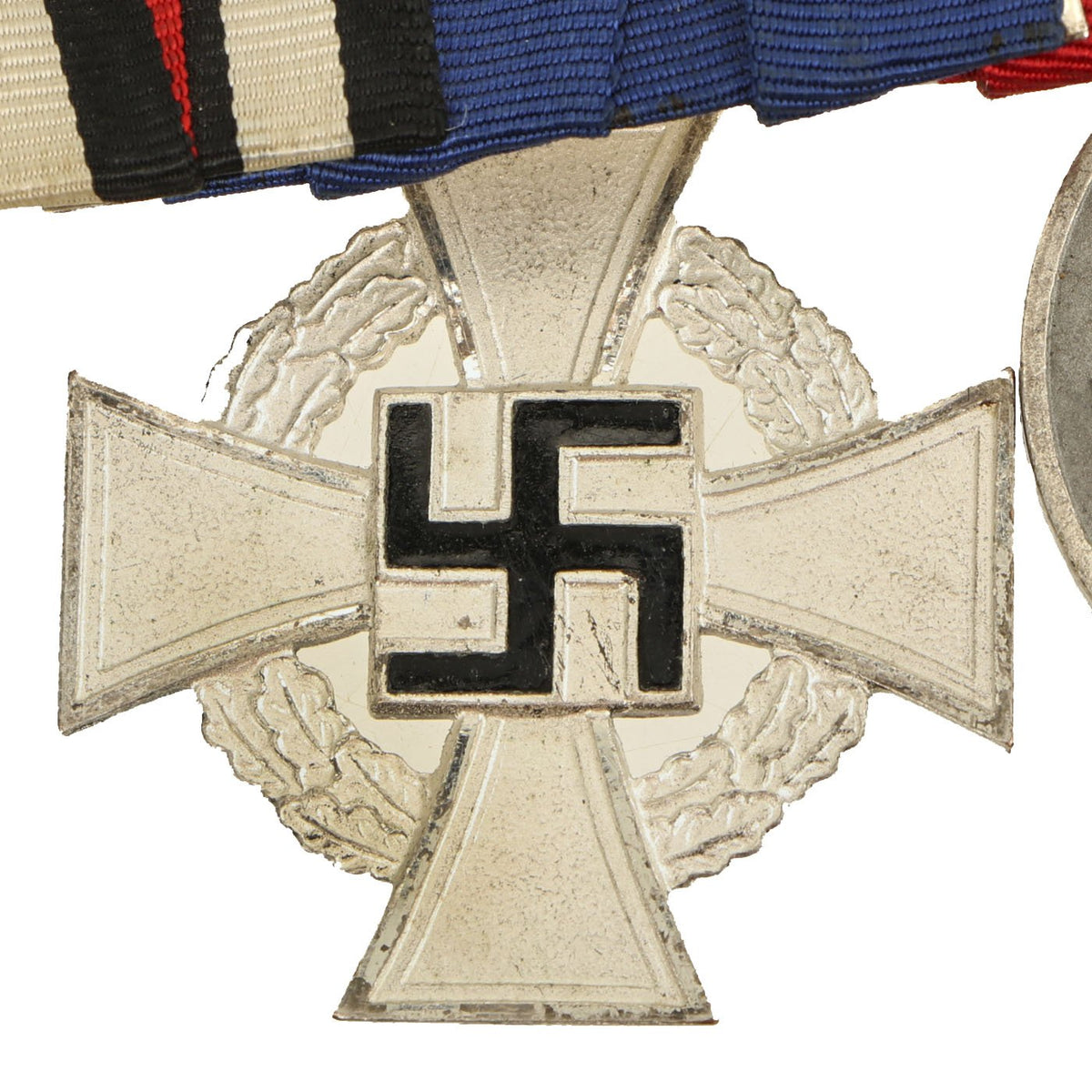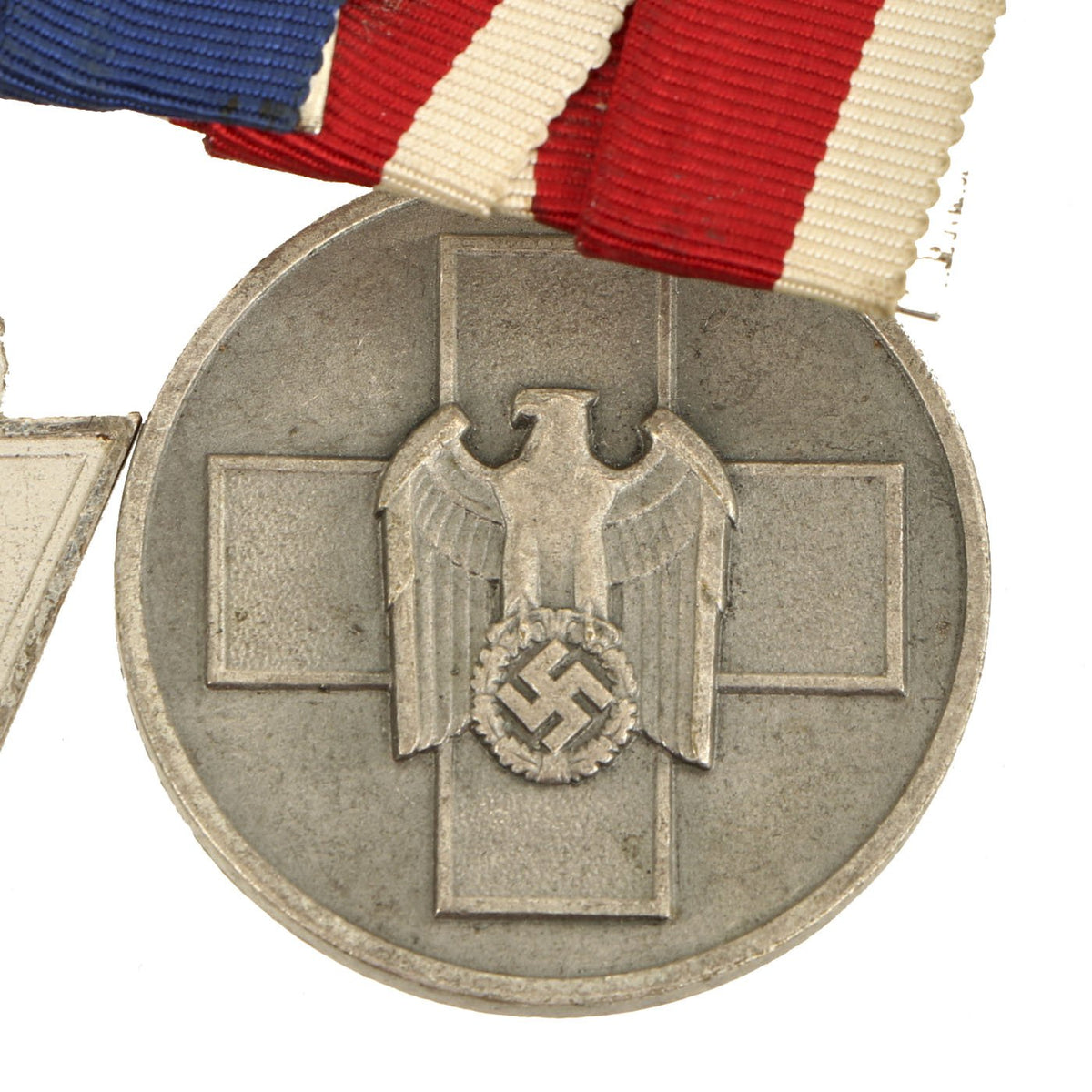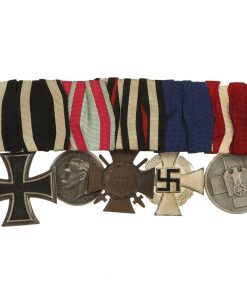Original German WWI & WWII Era Medal Bar with EKII, Hessian Honor Decoration & DRK Medal – 5 Awards Original Items
$ 495,00 $ 148,50
Original Item: One-of-a-kind. This is a very nice genuine medal bar, owned by a German soldier who fought during WWI, and was apparently from the Grand Duchy of Hesse. He then served again during WWII, earning additional decorations. The colors on the ribbons are quite nice, making this a very attractive piece.
The set of 5 medals offered in good condition is mounted on a metal backing board with a long attachment pin, and consists of the following medals:
– Imperial German WWI Iron Cross 1914 2nd Class Medal (Eisernes Kreuz 2. Klasse, or EKII)
– WWI Hessian General Honor Decoration for Military Service
– German WWI Honor Cross of the World War 1914/1918 (Hindenburg Cross) Medal
– German WWII Faithful Service Decoration 2nd Class Cross for 25 Years of Service
– German WWII DRK Red Cross Medal for Social Welfare
Below is an explanation of each medal in detail:
German WWI Prussian Iron Cross 2nd Class with Ribbon:
Established by Frederick William in 1813 for gallantry in action, the Eisernes Kreuz (EK) decoration was revived several times for later conflicts. The bulk of the issues are divided into 1st and 2nd class versions, but a rare and superior ‘Grand Cross’ was also awarded for successful field commanders. During WW1 the lower decoration was freely awarded with 5½ million second class types issued. Originally, the Iron Cross was an award of the Kingdom of Prussia, however given Prussia’s pre-eminent place in the German Empire formed in 1871, it became an award for all of Germany.
The basic design of the WW1 crosses is a central cross patee struck from iron and mounted in a silver frame which has a raised crenulated decorative border. The obverse of the cross bears the date 1914 under a crowned ‘W’ monogram. Reverse bears an oak leaf cluster with the date of the decoration’s institution, 1813 underneath – the crowned initials of Frederick William are in the top arm above the oak leaf cluster. Suspension for second-class types is by means of a ring, and frequently this ring bears a maker’s stamp.
Please examine the edge seam for authentication, which is not present on reproductions. Iron crosses were commonly constructed from an iron core sandwiched in a surrounding two part silver frame, normally the seam of these two silver parts is visible around the edge of the cross as is seen on this fine example.
With so many Iron Crosses issued in WWI, it was inevitable that soldiers who already had achieved the 1914 version of the award might receive another during WWII. When the 1939 Iron Cross began being issued, they also introduced the Clasp to the Iron Cross (Spange zum Eisernen Kreuz). This way, a holder of the 1914 Iron Cross could be awarded a second or higher grade of the 1939 Iron Cross. To permit the two medals to be worn together, a “1939 Clasp” (Spange) would be worn on the original 1914 Iron Cross. It depicted a national eagle clutching an oak leaf wreath surrounding a swas above a trapezoid bearing the year 1939.
Hessian General Honor Decoration for Military Service
The General Honour Decoration (German: Allgemeines Ehrenzeichen) was a civil and military decoration of the Grand Duchy of Hesse. Established 25 September 1843, the medal could be awarded to recognize several different accomplishments or merits. The reason for the award of the medal was determined by the inscription on the reverse of the medal, with the obverse bearing the effigy of the reigning Grand Duke of Hesse.
The back of this example is marked FÜR KRIEGS-VERDIENSTE (For War Merit) on the back.
Hindenburg Cross with Crossed Swords (for combat):
The Honor Cross of the World War 1914/1918 (German: Das Ehrenkreuz des Weltkriegs 1914/1918), commonly, but incorrectly, known as the Hindenburg Cross was established by Field Marshal Paul von Hindenburg, President of the German Republic, by an order dated 13 July 1934, to commemorate the distinguished deeds of the German people during the First World War. This was Germany’s first official service medal for soldiers of Imperial Germany who had taken part in the war, and where they had since died it was also awarded to their surviving next-of-kin. Shortly after its issuance, the government of NSDAP Germany declared the award as the only official service decoration of the First World War and further forbid the continued wearing of German Free Corps awards on any military or paramilitary uniform of a state or NSDAP Party organization.
This example is marked on the back with G4.
Faithful Service Decoration Second Class Cross for 25 Years of Service – A fullsize frosted silver with an oak leaf wreath and black enameled swas (hook cross) on original ribbon.
The Civil Service Faithful Service Medal (Treudienst-Ehrenzeichen für Beamte Angestellte und Arbeiter im öffentlichen Dienst) was a NSDAP Germany medal of honor that was founded on 30 January 1938, in two grades, to reward civilians and military in the employ of the German public services for long and faithful service.
All officials, employees, and laborers at any level of the public service (local, regional or national) who complete 25 or 40 years service were eligible. The second class award was for 25 years of service was a silver cross, with a silver wreath and a black enameled swas in the center of the cross. The first class award was for 40 years of service was a gold cross, with a gold wreath and a black enameled swas in the center of the cross.
The reverse of both classes was stamped with Für treue Dienste (For faithful Services). in German black letter typeface. The ribbon for the medal is cornflower blue.
German WWII DRK Red Cross Medal for Social Welfare
The Social Welfare Decoration (German: Ehrenzeichen für deutsche Volkspflege) was a German Civil Award created by Adolf AH on 1 May 1939 for services in the social sector. The decoration was issued in three classes and was awarded for a wide variety of service, in the social sector, to the German state. Qualifying service would have been with Winterhilfswerk, National Socialist People’s Welfare, medical and rescue work, or care of foreign and ethnic Germans. As a replacement for the German Red Cross Decoration, it was conferred in four classes consisting of a white-enameled gold Balkenkreuz with Reich eagle and swas. A “Medal for Social Welfare” was also issued for lesser degrees of service, not warranting the higher presentation of a class award.
The main requirement for the award was that the service rendered should be to the benefit of the civil population. Reinhard Heydrich was awarded the decoration for his running of the Gestapo in the 1930s and for providing “security” to the German people. The infamous Doctor Josef Mengele was also awarded the decoration in 1941, for providing medical services to wounded soldiers and civilians alike on the battlefields of the Eastern Front.
Fast Shipping with Professional Packaging
Thanks to our longstanding association with UPS FedEx DHL, and other major international carriers, we are able to provide a range of shipping options. Our warehouse staff is expertly trained and will wrap your products according to our exact and precise specifications. Prior to shipping, your goods will be thoroughly examined and securely secured. We ship to thousands clients each day across multiple countries. This shows how we're dedicated to be the largest retailer on the internet. Warehouses and distribution centres can be located throughout Europe as well as the USA.
Note: Orders with more than one item will be assigned a processing date depending on the item.
Before shipping before shipping, we'll conduct a thorough inspection of the items you have ordered. Today, the majority of orders will be delivered within 48 hours. The delivery time will be between 3-7 days.
Returns
The stock is dynamic and we cannot completely manage it because multiple stakeholders are involved, including our factory and warehouse. So the actual stock may alter at any time. It's possible that you may not receive your order once the order has been made.
Our policy is valid for a period of 30 days. If you don't receive the product within 30 days, we are not able to issue a refund or an exchange.
You can only return an item if it is unused and in the same state as the day you received it. You must have the item in its original packaging.
Related products
Uncategorized
Armoured Fighting Vehicles of the World: AFVs of World War One (Hardcover Book) New Made Items
Uncategorized
Uncategorized
Uncategorized
Uncategorized
Uncategorized
Uncategorized
Band of Brothers ORIGINAL GERMAN WWII Le. F.H. 18 10.5cm ARTILLERY PIECE Original Items
Uncategorized
Uncategorized
Uncategorized
Uncategorized
Uncategorized
Uncategorized
Uncategorized
Uncategorized
Uncategorized
Uncategorized
